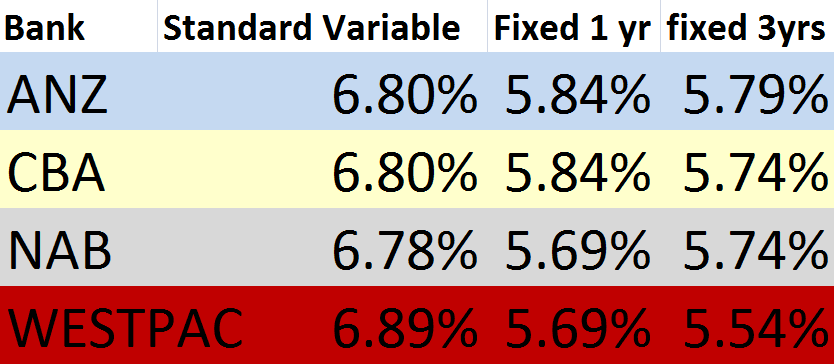Mortgage market
The big four Australian banks, who control about 90 per cent of the mortgage market, have provided their outlook on interest rates for the coming months. Westpac has forecast a cash rate of 3 per cent by year end, with a further 25 basis point cuts in the first quarter of 2013. Commonwealth Bank tips one more 25-basis point cut in the fourth quarter of 2012. National Australia Bank sees two more rate cuts ahead and expects rates to drop by 25 basis points in November and February and says we could also expect the RBA to cut rates as early as next month.
ANZ’s Head of Australian Economics provided his outlook last week, and forecast an interest rate cut next month on the basis of low inflation, moderate global growth and leading indicators of unemployment deteriorating. The cuts would see the official cash rate, currently at 3.5 per cent, fall to 3 per cent by the end of this year bringing it to the same level as during the GFC.
Interest rates of Australia’s four major banks  Current as at 26/09/12. The information in this table is provided as a guide only and may not be complete for your purposes.
Current as at 26/09/12. The information in this table is provided as a guide only and may not be complete for your purposes. Westpac cut its one-year fixed home loans by 20 basis points to 5.69 per cent and 30 basis points were wiped off its three-year fixed loans bringing the new rate to 5.54 per cent undercutting CBA’s three year fixed mortgages. And in a combating move, CBA is offering $700 cash to home owners who switch their mortgage from another lender. The offer will run until the October 31.
NSW residential building codes
Apartment owners in NSW will be represented by the peak strata body Owners Corporation Network in front of Fair Trading Minister Anthony Roberts this week. The owners Corporation is pushing for a review into building codes and non-structural defects. Earlier this year, changes to building codes were made relating to non-structural defects*, with warranty claim periods reduced from seven to two years. The push comes as the latest industry figures show 85 per cent of apartment owners have experienced building defects based on a unit block built from the year 2000 onwards. The strata body also acts to protect owners against increasing levies and compromised safety standards.
*Non-structural defects include fire safety, noise intrusion and water ingress.
Residential property market
Australian Property Monitors has posted the results of auction clearance rates across Australia’s capital cities at the weekend. Sydney boosted its stock levels as Spring sets in, recording a solid 67 per cent clearance rate from 355 properties for auction, Melbourne also spiked with a 63 per cent clearance rate from 240 properties, Brisbane was soft with only 4 properties listed and posted a 75 per cent clearance rate and Adelaide cleared 62 per cent from 26 reported auctions.
Commercial property sector
David Jones Limited
(ASX:DJS) is reportedly reviewing its property portfolio amid speculation the struggling retailer is attempting to attract genuine bidders for the company. DJ’s annual net profit plunged close to 40 per cent last week. Its four flagship locations across Sydney and Melbourne have been valued independently at $612 million accounting for more than half of its market capitalisation. DJ’s says it is embarking on a review on the best way to unlock and enhance their value. The department store has also taken on six new leases in Victoria and Queensland which are scheduled to open early next year.
A resurgence in office investments is on the horizon according to Colliers International. The residential and commercial property firm says transactions for CBD office buildings were ahead of prior years with $2.2 billion in sales volumes achieved so far this year. Colliers expects offshore investors to continue to dominate the sector and has identified 28 domestic and offshore wholesale funds and REIT’s that were looking to place about $17 billion into local office buildings.
According to a recent study by Morgan Stanley, office rents could fall five per cent over the next four years if employment growth continues to slow. Sydney and Melbourne are expected to be the worse off with rents tumbling by between 8 and 9 per cent. Brisbane will be better off with 15 per cent growth forecast.